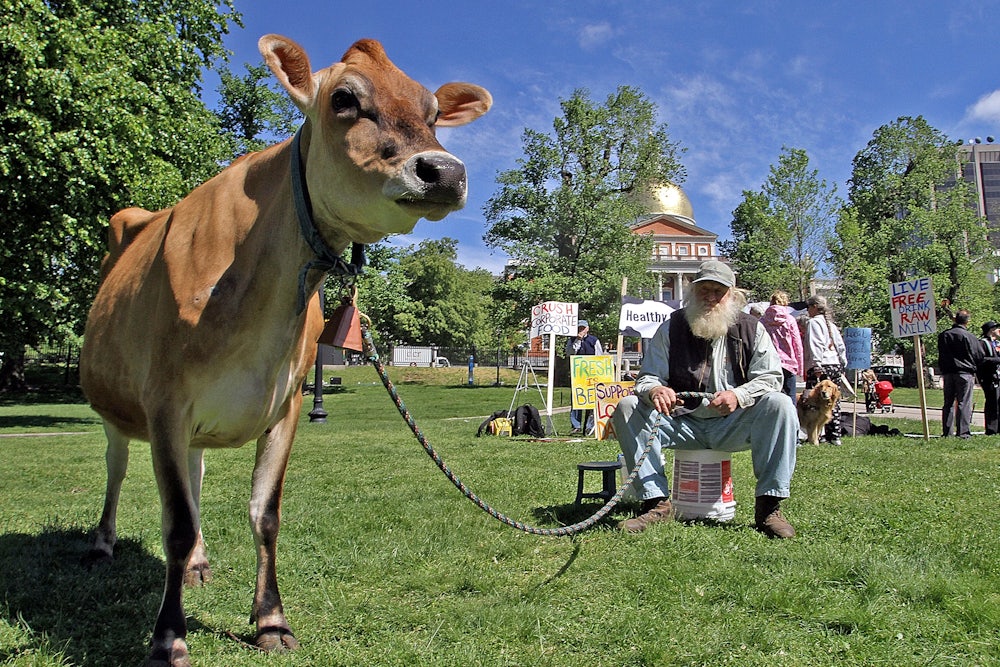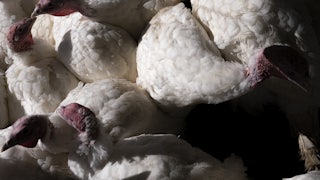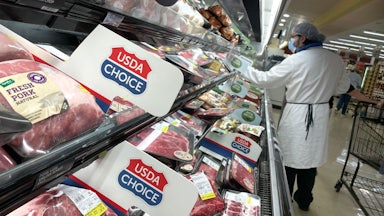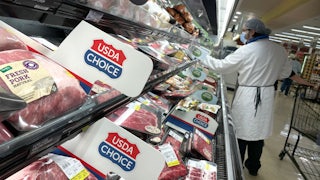At a busy farmer’s market on the outskirts of Annapolis, Maryland, the line in front of the raw dairy table moved briskly. A pregnant woman paid for a half-gallon, as “My Sharona” blared from the overhead speakers.
A man wearing a brown cowboy hat pulled jug after jug out of a cooler next to the table. Some people wanted raw milk cheeses, but most of them were there for the milk itself. He brought 140 half-gallons that Saturday, and a little after nine in the morning, there were only nine bottles left.
Selling raw milk for human consumption is illegal in Maryland. Each jug the man sold was labeled “Pet Milk” on the side, along with a required warning that unpasteurized milk can cause foodborne illness. But at no point in our conversation did the man ever talk about feeding the milk to pets. Instead, he told me that milk-borne pathogens are a myth, and that raw milk is key to staying healthy.
Sales of unpasteurized milk have increased by as much as 65 percent in the United States since bird flu was detected among cows in March. One raw milk vendor told the Los Angeles Times last month that customers are keen to drink milk contaminated with H5N1 in order to “gain immunity.” With the dairy industry in turmoil, raw milk influencers came out in force on social media, introducing millions of people to the evidence-free claim that pasteurizing milk is bad, actually.
When cows are infected, research shows that enormous quantities of the bird flu virus pass into their unpasteurized milk. Researchers have also found that mice ingesting tainted milk then got sick. So even if the line of people at the farmers market really were buying it for their pets, that’s still a very bad idea. Barn cats on affected dairy farms were extremely susceptible to the highly pathogenic avian influenza, including symptoms like blindness, and half of the cats died. Infecting your cat with H5N1 also means you would be exposed to the virus.
All this is on top of the many germs already found in raw milk. E. coli, salmonella, campylobacter, listeria, and some parasites—what Benjamin Chapman, department head and professor of agricultural and human sciences at North Carolina State University, called the “hit list”—can all be transmitted in milk that hasn’t been pasteurized. None of these illnesses are pleasant, and some can be very dangerous and even deadly, especially in pregnant people, immune-compromised people, children, and the elderly.
The upsides to raw milk, meanwhile, don’t seem to exist. Pasteurization may slightly affect levels of nutrients like vitamin C, “but milk’s not really a good source of vitamin C anyway,” Chapman said. Generally, “you’re not losing anything by pasteurizing,” Celine Gounder, infectious disease specialist and epidemiologist at NYU and Bellevue Hospital and editor at large for public health at KFF Health News, told me. “The nutritional value isn’t changed by heating the milk.”
Yet drinking raw milk has become, as with so many matters of health, a politicized issue. Legislation to legalize raw milk recently passed the House in Louisiana, with a 95–0 vote and the slogan “Taste the liberty.” Iowa and Delaware are also in the process of legalizing raw milk sales. One virologist recently called for a temporary ban on raw milk sales, even in places where it’s legal, and the U.S. Department of Agriculture on Thursday recommended limiting raw milk sales.
It is already legal in 32 states to sell raw milk for people, sometimes with restrictions. States where it’s legal had 3.2 times more outbreaks of illness due to unpasteurized milk from 1998 to 2018. “Raw milk is risky. It’s riskier than a lot of other foods,” Chapman said. “And when you add in the highly pathogenic avian influenza, it’s only adding to that risk.”
But the problem isn’t just that raw milk drinkers could make themselves sick. By potentially infecting themselves with avian influenza, they risk endangering others as well.
Every time someone comes into contact with H5N1, the virus has a new opportunity to mutate, spread, and sicken everyone else. “It’s like a coin flip,” Gounder said. If you flip a coin once, your chance of getting heads is only 50-50. But if you flip it a hundred times, the chance of getting heads at least once is very high. Viral evolution is the same way. “The probability of seeing the kind of mutation that would allow for person-to-person spread goes up with each person that infects themselves,” Grounder said. “And that’s a situation in which this could become an epidemic or pandemic.”
At a break in the dairy line, I approached. The man beamed at the opportunity to tell me about the benefits of raw milk. Pasteurized milk, he said, can lead to heart disease, whereas unpasteurized milk wouldn’t.
“Is it still OK to drink given, you know, all this?” I gestured vaguely at someone masked nearby. If possible, he beamed harder. It wasn’t just safe; it was good for me, he said, like breast milk is good for my baby. (Breast milk is also pasteurized before being shared with babies who need it.)
I asked whether he worried at all about bird flu. “It’s not real,” he said. “It’s not real?” I asked. He shook his head and slid a printout toward me. “This will answer all your questions,” he said.
The printout was a blog post from the Weston A. Price Foundation, a group spreading health misinformation, claiming pathogens aren’t carried in milk. “But this is talking about brucellosis,” I said. He shook his head. “Read the whole thing. Bird flu isn’t in cows,” he said. There was only one case in a dairy worker, he said, and that was only an eye infection. “That man works in a large confinement dairy,” he said, even though no identifying data like this has been released for human cases of H5N1, of which there have been three so far. “He probably gets pink eye every other week in a place like that.”
Kyle, 25, snagged one of the last bottles of raw milk. He was thrilled when he searched online and found a raw milk vendor so close to where he lived. He’d started drinking the unpasteurized milk three weeks earlier, and he believed it gave him more energy, which made him more sore after his workouts, which was what he wanted. I asked if he was worried about negative health effects; he wasn’t. As for bird flu, he said, “that was affecting the bred-to-produce-milk dairy cows, like the ones that are government subsidized.” With this local dairy, “their herds are isolated, so they’re not going to be in contact with any of those genetically modified sick cows.”
There’s a grain of truth there. The more animals there are on a farm and the closer they live together in unsanitary conditions, the more likely it is that pathogens will spread. But that doesn’t mean small operations are off the hook for germs like H5N1. The virus spreads through domesticated and wild birds and other animals—and, possibly, through human workers from other farms. Small farms “have to worry about it as much as a large producer,” Chapman said. “It’s not like small farms are immune to the pathogen.”
H5N1 infections among cows have by and large been detected in larger commercial operations, Gounder said. “But that’s not to say that other cattle are impervious to this.” The results may also be a product of who is doing the testing. If small dairy operators—for instance, the man I met at the farmers market—don’t take the virus seriously, they likely won’t test.
Right now, dairy producers are only required to test their milk if they are shipping cows across state lines. Yet commercially available milk has high quantities of inactive fragments of H5N1, which researchers believe indicates that the virus is spread among many more cows than official tallies indicate. And it’s not always clear when a cow is infected; some do not display symptoms.
“Unfortunately, not testing does not mean that something does not exist. It means you’re just not looking for it,” Gounder said.
But what about the idea that drinking raw milk could give you immunity against bird flu? If you were to get sick from drinking tainted milk, “you may gain immunity, if you’re lucky, to the current strain that’s circulating among dairy cattle,” Gounder said. “However, if the virus mutates to be transmitted from person to person, the chances that you would still have immunity to the virus at that point, and that that immunity would be protective against what would be a mutated virus, is pretty unlikely.”
And there is always that tricky part about first knowingly infecting yourself with a virus that has a 50 percent mortality rate among people, just so you can protect yourself against the same virus. Drinking raw milk “could potentially lead to a real illness that [you] might not be able to recover from,” Chapman said. “The best way to get immunity for any disease is really through vaccinations.” Seasonal flu vaccines, for instance, provide good protection against many of the strains that make humans sick.
The appeal of raw milk may have to do with a different but related phenomenon in food: the idea that processed food is bad for us and that the closer it is to its natural source, the healthier it is. Ultraprocessed foods, after all, can be terrible for our health. But cooking doesn’t change the nutrition of milk—it makes it safer.
“People want a sense of control,” Gounder said. “And I think unfortunately our health care system in this country is so dysfunctional, people feel disempowered and out of control. And this is a way of taking that back.”
While flagging trust in regulatory bodies is understandable given some recent failures, sidestepping regulations entirely is even more dangerous. Parachuting out of an airplane can be thrilling, even make you feel invincible, Grounder said. But “it’s not because jumping out of an airplane per se makes people stronger. It’s the high of doing something risky and surviving it.”








